A Most Merry and Illustrated History of
The Life and Times of Thomas Eakins
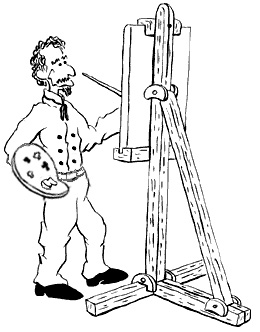
Tom at work
Eakins Scholarship, AVP (After Van Pelt)
In the early 1960's, one of the "Peanuts" comic strips had its three major characters, Linus, Lucy, and Charlie Brown, describing what they saw in a formation of clouds. Linus said he saw the map of British Honduras, and another set of clouds gave him the impression of the stoning of St. Stephen. He could see the Apostle Paul standing off to one side. There was also a cloud, he said, that looked a little like the profile of Thomas Eakins.
This was probably the first time most Americans had heard of Thomas Cowperthwait Eakins, even though Linus called him "the famous painter and sculptor." Obviously, the strip's cartoonist, Charles Schulz, felt your average comic strip fan needed the added explanation, and part of the joke, of course, was that Linus - the youngest of the "Peanuts" crowd - would even know who Thomas Eakins was (Charlie Brown, by the way, saw a ducky and a horsie).
Recently Tom has gotten a fair amount of publicity, but for nearly half a century after Linus Van Pelt first introduced Tom to the American people, he remained largely unknown even in own land. Your average citizen knew artists like Da Vinci and Michelangelo, certainly and generally recognized the (for their time) far out painters like Renoir, Monet, and Gauguin. And everyone, of course, knew Picasso and Van Gogh.
But if you mentioned Eakins, you'd almost certainly draw a blank look. Just a few years ago, one of Tom's biographers flatly assumed most readers had never heard of him. And if the Eakins fans think that was bad, you should have tried going over to Europe. When a film maker showed up in Paris with cameras and crew to film a documentary about Tom, the staff of the Louvre didn't even know who he was.
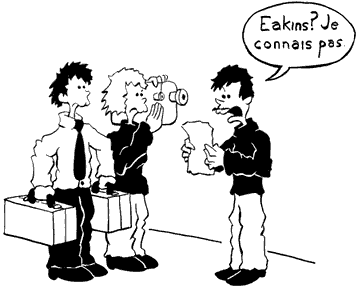
At the Louvre
During his own time, though, Tom was well enough known. Whenever he exhibited his art, the papers would take notice, and at least one critic, after seeing one of his paintings, went out of her way to meet him. Perhaps the most telling point is that when John Singer Sargent, the most renown portrait painter of his day, was visiting Philadelphia, his host asked who he'd like to meet. "Well," John replied, "there's Eakins." So people knew who he was.
What happened to Tom (and his reputation) is both interesting and instructive. In particular, it shows the need for being in the right place at the right time. As an artist, Tom Eakins was a "realist", or as some prefer, a "naturalist" painter. The latter term is not to be confused with someone who paints animals, plants, and birds. Instead, Tom's paintings showed pretty much ordinary people doing ordinary things. There were rowers rowing, hunters hunting, boxers boxing, doctor's doctoring, or ladies just sitting around the house. But in the last quarter of the nineteenth century, mainstream art mostly depicted cherubic nymphets gamboling through the meadows or stately religious figures striking heroic poses. That's what people wanted to buy, anyway, at least the people with money.
But as soon as the craze for the historical romanticism was over, the patrons of art took an immediate left hand turn leaving Tom and his art in the middle of the road. By 1890, Impressionism had long lost its outlaw status, and as early as 1905, Picasso and his friends had already become the rage among the rich and famous. By the time World War II ended and Jackson Pollock began tossing paint all over his floor, Tom's paintings looked old fashioned even though they had never really been in vogue. So once ill-health forced Tom to retire around 1912, he spent his sunset years living in a house full of unsold pictures.
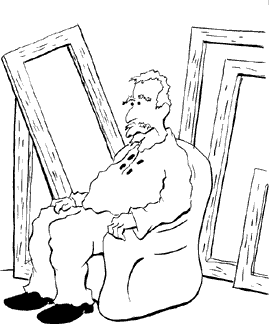
Tom's Sunset Years
But producing out-of-step art wasn't Tom's only problem. He had a distinct knack (if you want to call it that) for inviting controversy that regularly exploded into scandal. During his lifetime, he was accused of everything from being obnoxious to practicing bestiality. The former is a matter of opinion, of course, and the latter is patently absurd. Tom liked animals, certainly, but not that much.
Philadelphia and Family
Thomas Eakins was born on July 25, 1844 in Philadelphia. The family lived a little less than a mile north-northwest of Philadelphia's City Hall in a nice house on Mount Vernon Street (which is still there). His dad, Benjamin was a "writing master", that is, a professional calligrapher and penmanship teacher. Benjamin was really quite good at his job (as surviving samples show) and in the pre-computer days a man with Benjamin's skills was much in demand. After reading a bit about Tom though, you quickly realize the Eakins family must have had more money than penning wedding invitations and graduation certificates would bring in.
And they did. In his younger years Benjamin worked hard and saved enough money to invest in Philadelphia real estate. Eventually he owned a number of buildings which housed some of Philadelphia's lower rent apartments. It's not clear how conscientious he was in keeping the places up, and one author even referred to Benjamin rather discourteously as a "slumlord". In any case, the Eakins family had money, and they had eventually accumulated enough capital so when Tom began to study art Benjamin reportedly told his son, "Tom, you learn to paint as well as you can. You'll never have to earn a living." As you might guess, Tom had great respect for his dad.
Tom had three younger sisters: Francis (Fanny), Margaret, (Maggie, his favorite), and Caroline (Caddy). You can take your pick as to what home life was like. According to some biographers, it was a loving, happy family where Tom and his dad spent many hours in manly father/son activities like hunting and rowing on and around the two major rivers in Philadelphia. Others say it was a completely dysfunctional family whose stern/no-nonsense patriarch wouldn't even let the family talk during mealtimes. In the early years at least, it was likely the Eakins clan was like any other family, and people sometimes got on pretty well and at other times got on each other's nerves. Later on though, events support the less favorable interpretation.
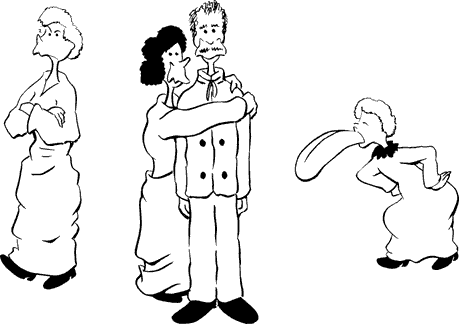
The Eakins kids: Fanny, Maggie, Tom, and Caddy
Tom's mom was the former Caroline Cowperthwait and like many proper nineteenth century ladies is a somewhat shadowy figure. She died relatively young (fifty-two) after suffering from "exhaustion from mania". Apparently her problems were more serious than the usual nineteenth century ladies difficulties, and from a rather cryptic reference in the family's correspondence, it looks like Mrs. Eakins may have spent some time in a mental institution.
No one really knows what ailed Mrs. Eakins since "mania" was just a nineteenth century generic term for mental illness (hence the term "maniac"). Since she unduly worried about Tom when he was away from home she may have had what is now called an "anxiety" disorder. Others say she was bipolar, or in popular jargon, manic-depressive. The trouble is this is a rather trendy tag that has been put on virtually any historical figures worth writing about. If you look at your typical "Famous Manic Depressives" list, you'll find people like Mark Twain (which is possible), Vincent van Gogh (he had problems, but was not likely bipolar), F. Scott Fitzgerald (alcoholic, yes; manic depressive, no), Sigmund Freud (probably just hyper from nicotine addiction), and some guy named Thomas Eakins.
Exactly how Caroline died isn't clear since few mental illnesses are fatal per se. But in that day and age, women's complaints (and a lot else) were treated with mixtures of alcohol and opium and what is now courteously called substance abuse was quite common in older women. So Mrs. Eakins may simply have been in the final throes of drug addiction.
Education a la Francais
Tom attended Philadelphia's Central High School, which with its strong technical and science curriculum, was one of the best in the country. At that time there wasn't a great distinction between a very good high school and a college and you could in fact get a bachelor's degree from Central High (which Tom ended up doing). Tom was a pretty good student he had done particularly well in mechanical drawing, and surviving examples of his work show an artistic aptitude well advanced of his years.
Tom wasn't quite sure what he wanted to do when he got out and for a while he helped his dad out penning forms and certificates. He was a good calligrapher (his handwriting was beautiful) and he applied for a job as a writing teacher at his old school. He and the other applicants had to take a series of tests to decide who would get hired. Tom placed second, and after failing to get the job, he decided there was more to life than teaching penmanship. He had also been a strong student in his science courses and in a day and age where science and art were not as separate as they are today, Tom vacillated a bit on whether to be a doctor or an artist. Finally, he chose the latter.
The trouble was there was a war on (the Civil War, that is) and when Tom graduated in 1861, Lincoln had just called for 75,000 volunteers. When they weren't forthcoming, Father Abraham instituted the second national draft (Jeff Davis had beaten him to the punch there). Back then they didn't have draft deferments per se, but you could still "hire" a substitute to take your place on the battlefield. Tom (or rather Tom's dad), paid the $300 exemption fee, and while most of Tom's classmates marched off to Shiloh, Antietam, and Gettysburg, Tom began to study art. He spent five years at the (then) rather informal Academy of Fine Arts in Philadelphia, and in 1866 he sailed off to enroll at the famous L'Ecole des Beaux Artes in Paris.
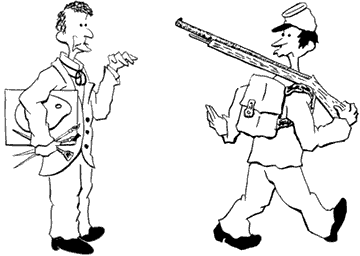
Deferment
The trouble is that you just couldn't wander into one of the Ecole's ateliers (teaching studios), pick up a brush, and begin to paint. It was the most prestigious art school in the world, and the number of foreign students was limited. So there's debate on how Tom got in.
According to one story (derived mostly from Tom), when he got to Paris he found the American quota was filled. But after a month of making a pest of himself, the French bureaucracy finally caved in and let him and four other Americans in. One biographer, though, says this is poppycock and an American barely out of his teens would not sway admission into what was for all practical purposes a department of the French government. On the other hand one of the other Americans said it WAS Tom's bullheadedness that did the trick. But whatever the truth, all five Americans got into the Ecole, and Tom began studying with one of the most famous painters of the day, Jean-Leon Gerome.
Gerome was a fantastically successful artist, and even today it's a good bet everyone has seen some of his paintings. He specialized in romanticized historical subjects (his most famous painting is probably the one about the gladiator about to kill an opponent while the Vestal Virgins all signal thumbs down). But he also excelled (and really excelled) in painting voluptuous female nudes whom he splayed across his canvases in various coy and sexy poses. Of course, no one would dare suggest that Jeon-Leon produced anything but "art", but it's also true that the conventions he adopted were (so I hear) almost indistinguishable from those of the men's magazines that cropped up following World War II, conventions that remained unchanged (once more so I hear) until after the more permissive sixties. So it's easy to understand why Jean-Leon had so many sales and successful showings at the prestigious Paris Salon where all the judges were men.

The Salon: All the judges were men.
Tastes come and go and it's been fashionable to pooh-pooh the artistry of Gerome and painters of his ilk. But the truth is Jean-Leon was an excellent artist and evidently a good teacher to boot. He was also quite open minded. Although the Ecole was an all-male school, he would give private art lessons to ladies, the most famous being the American, Mary Cassatt, who some critics think was a better painter than Tom.
Painting did not come easy to Tom, and later Jean-Leon wrote that he had harbored doubts about Tom's artistic future. He put Tom working at drawing and it's not certain how good Tom was at this stage. Some people say he could draw the human figure with professional aplomb while just out of his teens, but other scholars say some of his so-called student drawings were simply mis-dated and were actually drawn when Tom was in his thirties. Regardless of how good Tom really was, Jean-Leon soon advanced him from drawing to painting, and after Tom turned professional his pictures impressed Jean-Leon enough that he referred to Tom a "master". Later Jean-Leon accepted at least one student on Tom's recommendation.
By the time he left for France, Tom's had acquired about as much a Bohemian philosophy as was possible for a young man from the upper middle class strata of Philadelphia. But he was still pretty conventional if a bit sardonic. Under the tutelage of his Continental friends, though, he became even more worldly. The students at the Ecole, after all, were a pretty raucous bunch where horseplay and practical jokes were a continuous source of fun; that is, if you consider it fun when you frighten a new student so much he dies of a heart attack. That did happen.

Studies at the Ecole
Tom's years in Paris were a bit before the heyday of the Moulin Rouge and Monmarte, but Paris was still Paris. Tom wrote home dutifully to report how hard he was working, and yet when Tom's then-girlfriend, Emily Sartain, came to visit (along with Tom's dad and his sister Maggie) she was shocked at Tom's changed outlook. When she learned he was reading "trash" like Boccaccio and Rabeleis, she told him he should go back to reading authors like Shakespeare and Carlyle (whoever he was). Eventually Tom and Emily (herself a quite assertive and progressive young woman) let their relationship slide.
Still, Tom was diligent and kept struggling to improve. Like many beginning painters, he had a lot of trouble stopping his colors from looking muddy and once Jean-Leon even had to take the time and mix the colors for him. At the end of three years Tom had not passed any of the required examinations and wasn't even close to graduating, much less having anything to submit to the Salon. He decided not to stay any longer, though, but on the advice of another famous painter, Leon Bonnat, he traveled a while in Spain. There he painted his first "real" picture, a street scene of some musicians. It was pretty rough and it wasn't until later that he showed he could paint with the polish of Gerome if he really tried. In 1870, Tom returned home.
Painting in Philly
When Tom got back to Philadelphia, he found out his dad had set up an attic studio in the family home. Benjamin had first intended that father and son could do their own work side by side and so work in a bit more congenial atmosphere than if they each penned or painted alone. Although this was no doubt a good faith gesture on Benjamin's part, he also might have wanted to keep a bit of an eye on his son who after three years in Paris had learned the joys of carousing.
Tom, though, knew that as an artist he would likely be drawing quite a few naked women. At the very least he reasoned this might be a bit distracting to the older gentleman as he wrote out invitations to the latest church social. Also female models, even if they posed in the presence of a chaperone, usually preferred to remain anonymous. So Tom struck a deal with his dad. He promised to pay $20 a month rent for the exclusive use of the studio on the understanding he could bring in pupils, models, and "whoever he will", all of which would be held in "professional secresy" (Tom, like most everyone today, sometimes didn't spell so good). But since he sold virtually nothing and never acquired any paying pupils, it's not clear where the $20 a month came from. Probably Benjamin just didn't bother him about the money.

Professional "secresy"
With carte-blanche from his dad, Tom took up his brushes and palette and began to paint. Within a year, he had completed a picture of his friend Max Schmidt in a rowing scull on Philadelphia's Schuylkill River. The painting is now considered a milestone in American art, but when Tom submitted it to a local exhibition, the enthusiasm was a bit more muted. Still the reviews weren't all that bad, especially for a young and unknown artist.
So with a pretty good start, Tom jumped into being a professional artist, assuming he would be able to start earning his own living. He began expanding on his outdoor scenes, painted more rowing pictures, and if nothing else, he said, he could always make a living painting portraits.
Despite the more or less auspicious beginning, Tom's sales - to use today's rather hackneyed business jargon - did not meet the projected expectations. In fact, virtually no one wanted to buy his paintings. The sitters inevitably hated his portraits and at times they even refused to pay. Some critics of Tom argued part of the problem was he couldn't really paint a good likeness, when in truth he could capture a likeness all too well. His fellow artist Edward Abbey jokingly refused to sit for Tom, saying the painting would show all the disagreeable traits he'd been trying to hide for years.
So almost a decade after returning home, Tom was still earning hardly anything. In eight years, from 1870 to 1878 he had made a total of $140, a very low rate of return even in nineteenth century currency. But Tom's dad kept paying his son's way, which has to be one of the most remarkable testaments for any father's confidence in his offspring, particularly since Benjamin kept it up even after Tom hit the tender age of 55. And when Benjamin died he left Tom both the house and enough money so Tom could keep living at Mount Vernon Street.
So what was the problem with Tom's paintings? The usual criticism was Tom showed great technique but rotten taste. This is no better illustrated than the time he was asked to paint Jefferson Hospital's famous surgeon, Dr. William Gross, in 1875. Not content with a simple portrait, Tom painted Dr. Gross operating on a patient while his medical students looked on. Dr. Gross turns away, slightly off center, while his assistants huddle over the patient whose mother cringes at the extreme left of the painting. It was a masterpiece of composition and lighting and is considered one of the greatest paintings by any American artist. Everyone hated it.
Tom submitted the painting to the American Exhibition in 1876, celebrating the country's centennial. By today's standards - where producers of educational television delight in zooming in on gaping sucking wounds as the patients are writhing and screaming on the emergency room tables - the reactions seem ludicrous. Some of the judges, seeing the red paint on Dr. Gross's scalpel, literally got so sick they had to leave the room. They rejected the painting from the exhibition galleries, but as a consolation prize allowed it to be hung up in a mock up of a Civil War hospital tent. Reportedly Tom wept with frustration.
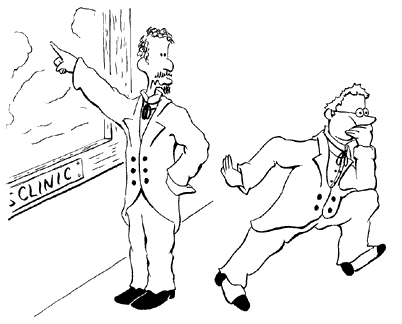
The painting was rejected.
Despite the Gross portrait debacle, Tom was almost immediately asked by the Union League, a Philadelphia men's club founded during the Civil War, to paint a portrait of the newly elected President (and former Union general), Rutherford B. Hayes. So he went down to Washington, and once more painted a picture no on liked. That, though, was hardly Tom's fault. For one thing, Hayes didn't want to sit for the portrait in the first place, and in the second place, the President kept moving around so much, writing notes, and talking with visitors that Tom had to use techniques usually reserved for drawing animals. The results were predictable. The president's friends thought it made Hayes look like he'd had an early afternoon toddy, and Mrs. Hayes absolutely hated the picture. Someone (probably Mrs. Hayes) stuck the portrait off somewhere, and it hasn't been seen since.
Two strikes and Tom was out. He had great technique but rotten taste. After a while, the critics, being critics, began parroting each other, and it didn't matter what Tom painted. He had great technique, but rotten taste, and that was that.
So by the time he was in his mid-thirties, it looked like Tom Eakins was going to be a rotten biographical subject. The truth is that the lives of most artists actually make pretty dull reading unless there's something really wrong with them. If you read a book about Renoir, you'll find he mostly painted and hung out with his friends. Degas drew pastels, made sculptures, painted pictures, and traveled around a bit.
Fortunately (or unfortunately), Tom's life did have a bit more to it than painting pictures no one wanted and living off his dad's income. It all started when he volunteered to be an unpaid stand-in for Christian Schuessele, an increasingly infirm professor at the Pennsylvania Academy of the Fine Arts.
Teaching at the PaFA
The Pennsylvania Academy of the Fine Arts (known euphoniously as PaFA) was founded in 1805 after a number of false starts by a group of local artists, among them Charles Wilson Peale, one of the premier painters of the Revolutionary era. But even after more than half a century, instruction had remained pretty informal. When Tom was a student, the Academy charged no tuition, and the teachers received no pay. But gradually it developed into a modern art school with regular faculty and a board of directors. In 1870 the Academy shut down for six years while a new building was constructed. During the down time, a group of students formed the Philadelphia Sketch Club and asked Tom if he'd be their (unpaid) instructor. He agreed.
From all accounts Tom was a kindly instructor. No doubt remembering his own struggles with brush and palette, he encouraged his students with patience and constructive criticism. Word must have gotten back to the PaFA board of directors and they decided that whatever Tom lacked in artistic taste he made up as a teacher. So when the school got going again in 1876 (and now charging tuition), they accepted Tom's offer to serve (unpaid) as an assistant to Professor Schuessele, who during the shutdown began having major health problems.
Schuessele (himself a very good artist) began teaching in 1868, but by the mid 70's, he was suffering "paralysis and palsy", a typically vague Nineteenth Century medical diagnosis. Whatever the exact affliction the disease took a galloping course. As Schuessele's health continued to fail, Tom took over more and more of running the classes. Since he didn't get paid, he felt free to do pretty much as he wanted. His own preference was to focus mostly on drawing the nude figure and allow students to start painting right away rather than serve an apprenticeship in drawing. He also wanted to reduce or eliminate still life and composition.
To Tom, this wasn't any big deal - it was a lot like what they taught at the Ecole - but not everyone thought this was a good idea. For one thing PaFA was unusually progressive had no problems with admitting women or minorities (including African Americans). Given the fact that in that day and age most women (college graduates or not) almost always ended up as homemakers, still life was a favorite course. Also some people thought that there was a bit more to art than drawing naked people.
The story is that when the school's directors learned that Tom had started some night classes independently of Professor Schuessele, they demanded that Tom not teach unless the regular professor was personally there. Tom, never a man for compromise, left his job as an unpaid teaching assistant (a move that may not have been entirely voluntary) and took his figure drawing classes to a new sketch club, the Art Students Union. However, by 1879 Tom was evidently back at PaFA, and called (at least by a New York reporter) an assistant professor of paintng and prosector (i. e., demonstrator for dissections) in anatomy.
The reporter who gave Tom the lofty titles was from Scribner's Monthly (for which Tom had once supplied an illustration). It's worth dwelling on the article a bit since it's one of the few contemporary - and yet official - accounts we have of Tom at work. What clearly comes out is that although Tom wasn't in in charge yet, he was clearly taking over. Schuessele, a conservative, the reporter said, preferred to have students first draw from casts, and after a long apprentiship move on to painting. Tom though was a "radical" (direct quote) and pooh-poohed cast drawing as a mere "imitation"of life. When challenged that students should learn to draw first, he insisted that brush and paint were superior to "point or stump". But there was, the reporter hastened to say, "no conflict"among the teachers since the instruction was elastic. (And we really believe that don't we?)
Well, instruction was VERY elastic and what really threw the reporter for a loop was how prominent dissection was in a school where fully a third of the students were dainty Victoran women. But art students, then as now, rarely harbor society's mainstream views, and also we have to remember Tom was a science buff who once thought about becoming a doctor. His enthusiasm for mixing science and art really comes off here. He told the reporter how he'd take the students to suburban slaughterhouses (we have to remember that suburbs were not the havens of the upper and middle classes back then) and carve up horses. And as prosector he would supervise dissections of human cadavers right there in the school.
On being prodded, though, Tom admitted, yes, dissection was disagreeable and "dirty" business (but someone has to do it, we suppose) but students who didn't sign up for the classes soon found their art sufferred. Although he was quite articulate (at least in print), Tom did seem to fumble a bit when asked why the heck an art student needed to know where the spleen was. In any case, such emphasis on dissection was, the article said, "unique" in art instruction in America (and it still is), as was hooking a living subject up to an electric battery to show how his faced twiched when the juice was turned on.
By the time the article appeared, Professor Schuessele was in sad shape, and when he died toward the end of 1879, PaFA needed a full time painting and drawing teacher. Tom did have supporters on the board of directors (including the wealthy Philadelphia powerhouse Fairman Rogers) and he was hired to replace Schuessele. Now earning $600 a year and in his mid-thirties, Tom finally had a job.
Considering how much trouble Tom later got into, his tenure at PaFA - seven years - was quite lengthy. He immediately began making the changes he wanted. He focused almost entirely on figure drawing, required little or no cast studies, and he let the students start painting right away without spending much time drawing. He also added more courses on perspective and anatomy, and the latter included dissecting cadavers right there in the school.
At the school, one of Tom's most talented students was a young lady named Susan MacDowell. She was one of a group of girls that had written to the school's directors asking that Tom be allowed back after he left for the Art Students Union. When he did return she again became his student and Tom was impressed by her ability.
Susan saw Tom as something more than a teacher, and in fact she had been giving him the eye ever since she first met him in 1876. Tom must have also seen her as something more than a student. As she left class one day, he bowed politely and asked if he might button her glove. Susan was smitten.
Unfortunately (for Susan), at that time Tom was engaged to Kathrin Crowell, who was the sister of Fanny's husband, William. Although Tom did paint a pretty nice picture of Kathrin, most people think he didn't really like her all that much, and that it was his pop who had engineered the match to keep Tom from running around. In any case, the engagement dragged on until Kathrin died in 1879 just when Tom got started at PaFA. Susan and Tom quickly developed a closer than normal relationship for a student and teacher. She (quite voluntarily) began to serve as a model, both for Tom's paintings and photographs, as did some other of her friends. It took a while, but they finally married in 1884.

Tom offered to button Susan's glove
Trouble was brewing for Tom, though, and exactly where it started - like whether a falling tree makes any noise when no one is around - is one of the great mysteries of life. The situation is (like Tom) complex, but there's good evidence that the hullabaloo about Tom first troubles might have had something to do with his youthful romance with Emily Sartain. Emily's father, John, was on the faculty at PaFA, and whether her dad's mind was colored by Emily's now rather negative opinion of her old boyfriend is anyone's guess. But from the first, the two men didn't get on too well.
John was a skilled engraver and an old friend of the Eakins family. He probably gave Tom some of his first art lessons when Tom was a kid, and this could have caused some resentment. Seeing Tom - who he had known all his life - come in and start dictating how art should be taught in Philadelphia must have been a bit much for John to take. Tom, though, was now an energetic and forceful man of thirty-five, and he wouldn't have cared for an old fuddy duddy (particularly the father of an old flame) telling him what to do.
In the end, it was largely up to the board of director's to decide if Tom was to have the academic freedom he demanded. They sided with Tom, and John left PaFA in disgust while Tom crowed to his friends how he had bested his adversary.
The school was all Tom now. But with figure drawing being pushed so strongly, there was a problem with what the students could do for homework. Now if you're studying still life you can set something up in your house, but if you need a naked person for homework, the opportunities can really be limited. Models also cost money, and then as now the typical art student wasn't necessarily rich.
Tom's solution - which he suggested to his students - was that they just pose for each other. Some people say such a recommendation was daring and reckless, but in reality this had been a common, if a bit under-the-easel practice. There's even a painting by Tom's friend, Charles Fussell, showing Tom sitting and painting quite placidly and totally in the buff.
But now that there were ladies in the classes at least some level of decorum was required. This was the time, remember, that young brides were admonished by their mothers never to let their husbands see them completely naked or it might lead to unbridled lust and licentiousness which in turn would beget feeble children of degenerate character. But more to the point, we're told that students posing was in direct violation of the school's policy.
Sifting through the books on Tom, it's hard to say exactly what the school's policy was, and whether students posing for each other privately was forbidden. Also a letter from one of Tom's sisters implies that a student could act as a model as long as they had their parent's consent. Today, certainly, most art schools use models from professional agencies, but at places where such services are scarce, the students have been known to stand in. This is not without its hazards, of course, and at one large Midwestern university a student who was taking an art course volunteered to be the model. All went well until a tour group of parents and prospective students dropped by.
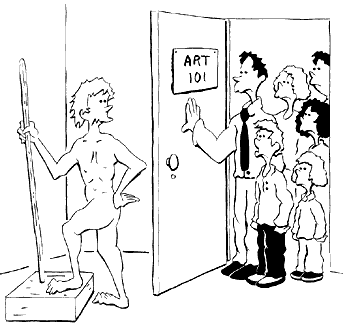
Parents Day at KU
For Tom, nudity for an artist should be approached as objectively as for a physician. You can't argue with that but Tom went a bit farther and felt that anyone who drew a naked person should have no hesitation in getting naked (medical boards, though, tend to frown on this philosophy in their doctors). Posing was supposedly voluntary, but Tom was a man with a mission. Although Tom's enthusiasm didn't bother a lot of the students, others began to feel that Tom's requesting or suggesting crossed the line into badgering and coercion. Or at least that's apparently what they said later.
Tom, a man who never had any qualms about shedding his clothes for friends and family (or anyone else), didn't seem to realize (or didn't care) that the idea of dropping your clothes in a room full of people can be rather uncomfortable for the average person. Once when a model didn't show up (this happens at art schools from time to time) Tom asked a young student if she'd pose (or at least show her back). She burst into tears and went home and told her father. The incident was later, so we learn, smoothed over, but it was a sign of things to come.
Certainly a congenial personality would have been a plus for anyone trying to convince people to take their clothes off, and at least part of the difficulty was that Tom did not always have a smooth and polished manner. Visitors who showed up at Tom's home or studio expected a stereotypical artist, sensitive and refined, spouting platitudes about art and beauty. Instead they found a quite ordinary man whose manners sometimes approached rudeness (Tom was from Philly, after all, the town that would one day snowball Santa Claus). He would, both friends and enemies said, sometimes use "coarse" or "filthy" language in mixed company and while painting portraits he could occasionally break wind with considerable gusto.
As far as using crude language, Tom himself admitted as much. In one letter he said in a lapse of judgment he once used suggestive language to some young ladies, although it seems he was just trying to crack a joke. And one another occasion there is independent confirmation of a "coarse" word Tom used to a female student. It was "pee".
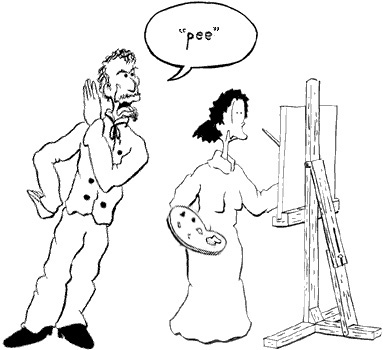
Tom was known to have used "coarse" language to the young ladies.
Still, many people saw this as nothing more than Tom's own brand of humor and took no offense. Certainly today some of his so-called antics would not cause an eye to bat. Once in a ladies' drawing class, they brought in a cow so the girls could draw it. As occasionally happens, though, the cow - and pardon if this sounds "coarse" or "filthy" - dropped a load on the floor. Tom was probably trying to defuse what he knew could be an embarrassing situation, and he called to his assistant Thomas Anshutz "Tom! I've just discovered a new muscle." Today such a remark would probably be greeted with good natured laughter, but at the time not everyone was amused.
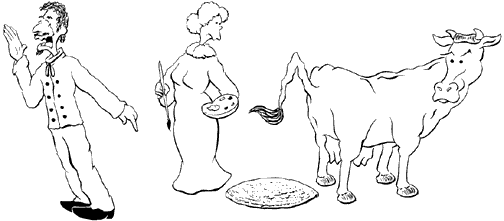
Tom said he found a new muscle.
The most notorious of all the more or less true Eakins stories is that Tom would expose himself to the young ladies. Some biographies of Tom mention this rather vaguely, and some readers might think Tom would routinely drop his pants in the middle of a class. That is NOT the case.
We have to admit that Tom did have enthusiasm for naked people. He not only liked to draw naked people but he sometimes drew naked people when in reality they weren't any naked people. One of his more famous pictures is the sculptor, William Rush, carving a statue draped in a diaphanous Greek gown (that is, the statue was draped in a diaphanous Greek gown, not Rush). The only problem is the model in the picture is entirely in her all-together, and although she's quite comely to look at, it's unthinkable a sculptor would use a nude model to carve a statue with clothes. But in Tom's own words (and in fairness we ought to take at least some of what he says at face value) he felt there was nothing more beautiful than the naked human body, even if it was an ugly, flabby, and old naked body. Tom liked figure drawing (nothing wrong with that) and he liked it a lot.
Now after a while spent drawing naked people, you start taking it all as a matter of course. People who knew Tom said he wandered around the house without his pants and that he sometimes even answered the door in his underwear (but there's still no answer to the Eakins-boxers-or-briefs question). This may seem strange to a lot of people, but if you spend a lot of time drawing nude figures, you can forget how much a lack of clothes isn't the norm. Recently an art student was on his way to class and was almost out his door before he realized he forgot to put on his pants.

Tom at home. Was it boxers?
Tom's parading around the house, though, was probably more than simple forgetfulness. Sometimes he took a real in-your-face attitude about nudity. There's a story about his student and friend, the sculptor Samuel Murray. A young lady was visiting Sam's studio while a model posed. Eakins, who was present, went to another room, shed his clothes, and returned, telling the lady he figured she had never seen a man naked. That was not a very wise thing to do but it was at a private studio, not at the school.
There is only one documented instance of this type of stuff happening during Tom's teaching years that actually involved a student. The source is Tom himself. What he said was that during one of the anatomy courses, one the girls was having some problems understanding the workings of the pelvis. Realizing a picture (or whatever) is worth a thousand words, Tom invited her to stop by his own studio (not at the school), and he'd make the point clearer. There - as Tom wrote - he was able to illustrate the point "in manner that could not be done by words alone." Again this wasn't really the thing to do, but the "illustration" was something the young lady herself agreed to. So it wasn't quite the same thing as Tom doffing his clothes in a classroom full of young ladies. In the meantime Tom - officially at least - remained in good standing with the school administrators.

Tom makes a point.
Tom and Technology.
Being professor and later director also brought him into contact with other academics and other schools. He began teaching classes at the Drexel Institute of Art and Sciences (now Drexel University), the Philadelphia School of Design for Women (now Moore College of Art and Design), and he even made trips up to New York to teach at the National Academy of Design. He was also instrumental in having Eadweard Muybridge come to Philadelphia and continue his photographic studies at the University of Pennsylvania. Eadweard, by the way, was his real name, not a misprint.
Muybridge is known to virtually all photography buffs as the man who made the motion picture possible. As told more or less accurately on the old "Death Valley Days" TV show (then hosted by a future President of the United States), Eadweard agreed to help Leland Stanford win a $25,000 bet that a horse's legs all come off the ground. This took a lot of work (plus a camera with a shutter speed of 1/1000 of a second) but he ended up with a series of pictures that when flipped proved his point, won the bet, and became the first motion picture. This was in California, but most of the motion photographs for which Eadweard was famous were taken at Penn.
Tom had been interested in photography for a long time. Unlike many artists he saw photographs not as a threat, but as a tool. At the time photography was difficult, the equipment bulky, and the developing process dangerous. But still once you got the pictures, you could take them to the studio and use them as references. Tom began to take his camera out into the field, take photographs, and bring them back home. Some of his most famous paintings were made from photographs, and those who look down on this should remember that Norman Rockwell also painted from photos.
The most controversial part of Tom's use of photography was when he experimented with projecting the image onto the canvas. This was discovered only in the 1990's by conservators using infrared analysis, and some people see Tom as somehow cheating by tracing the images. Actually Tom used the projections to block in the basic shapes as a substitute for the more traditional technique like transferring an image using gridlines. In the end he found photographic projection didn't save time or help him paint a better picture. After a few years he abandoned the technique.
One thing Tom did recognize was that the camera was an excellent means for teaching anatomy. He made a series of photographs of the nude figure at various angles and poses. Although excellent studies of the human figure in themselves, there was a problem. In some cases he not only posed for the pictures himself, but he had his students pose as well. As always, it's not completely clear to what degree Tom "strongly encouraged" the students to pose and how willingly they did so. Unfortunately, willing or not, Tom was headed for trouble.
Bounced Out
It only needed a small push for everything to come crashing down, and that happened in early 1886 with the famous "Loincloth Incident". This was, after all, Victorian America, and concessions had to be made to what were then the current standards of propriety. In the school's studios, for instance, if ladies were present, the male models had to keep their strategic areas covered (and for dissection classes the offending appendage was removed entirely). But during one of Tom's coed classes, he thought the students needed to see the way the legs connected to the torso, and he removed the loincloth.
At least one of the ladies complained, and many biographies of Tom say this is what he was dismissed for. But the initial response of the administrators was actually pretty mild. It might have remained a non-issue except it opened the door for other students to come forward and complain. Soon Tom found himself in a heap of trouble.
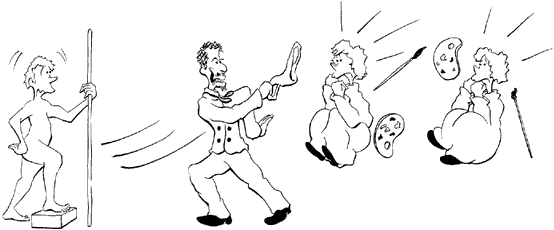
The "loin cloth" incident
But even then Tom might have weathered the storm if it hadn't been, oddly enough, for Tom's youngest sister, Caddy. Or at least it might have been Caddy's dislike of her brother that catalyzed the anti-Eakins chemistry at the school. By that time, Caddy had been married to George Frank Stephens who was a student at the Academy, and he probably hadn't heard much good about Tom. When Caddy had been a little girl, her cat had gotten sick (possibly with rabies) and their dad made Tom shoot the cat. Caddy never liked Tom much after that.
Now Frank was not only married to Caddy but he had a cousin, Charles, who was engaged to a young lady named Alice Barber. Frank and Caddy and Charles and Alice were a pretty tight bunch, and Alice had been one of the students (along with Susan, Tom's future wife and Susan's sister, Elizabeth) who had posed nude for Tom.
From what happened it's doubtful that Charles was aware of his fiancee's sessions with her professor, but somehow word got out about it. Not only did Charles find out but so did everyone in the school and now some of the more crass young men began making snooty comments about it. In the Nineteenth Century, it should be remembered, many of the models hired by the art schools were (to use a polite term) "sporting women" who were trying to pick up some extra cash. Ironically, Tom had been trying to get that element out of the school for a long time, and so having students pose was actually a quite respectable alternative. But the taint remained, and any woman who served as a nude model was likely to be the butt (no pun intended) of some snide remarks by the male students, many of whom could be crude in the extreme.
Alice seems to have been the one who suffered most from the taunts. In an effort to defend herself she told Charles that Tom had taken advantage of her innocence and had she not been so naive she never would have done anything so ill advised as taking her clothes off for Tom Eakins. So when the loin cloth incident hit the news, she was one of the girls (along with Elizabeth) who complained.
Alice also had Frank to help in the anti-Eakins cause. Now and likely urged on by Caddy, Frank joined in with a vengeance. He literally hated Tom's guts for the rest of his life, and according to Susan, Frank would almost go ballistic just talking about Tom.
It's impossible now to know what went on between Alice and Tom. A reasonable scenario is that she didn't really want to pose, but just went along with Susan and Elizabeth, both of whom had posed willingly (certainly Susan did). Then after Alice had to put up with the rude remarks of her fellow (male) students, she sincerely believed Tom was the one at fault, and the loin cloth incident gave her an opportunity to defend herself in an official forum. Likely she went overboard in making Tom look like the villain, but it's understandable given current Victorian standards which were even more Victorian in nineteenth century Philadelphia. At the same time, Tom could honestly believe that Alice, a grown woman, had given her consent and wondered what the heck was going on.
There were other factors working against Tom which had nothing to do with the ladies. Some of the other teachers - including some of Tom's assistants - never cared for the way Tom taught art. Not only was slicing up dead people a bit much to take, but Tom was a such a stickler for accuracy and precise rendering of the figure that some of the more intuitive artists felt they were being held back in developing their skills.
It's hard to deny that one of Tom' major faults was forcing his personal preferences onto an entire art curriculum, and a number of students and faculty felt that Tom was abusing his authority. It wasn't just people like Frank who may have been subject to personal influences, either. One of Eakins' most talented assistants, Tom Anschutz (who never denied Tom had done a lot for the school) wrote a note complaining about it. In any case, the artistic faction had solidified so much that some of Tom's biographers actually think they were the real force in driving Tom out. They had just bided their time until an opportunity presented itself.
An inquiry was held at the school, the records of which were either never kept or destroyed. Some of the correspondence between Tom and the administrators has survived, but it doesn't help us figure anything out. As far as we can tell he was accused of violating Academy policy by having students pose (which was true) and possibly of forcing students to pose against their will (and he very well may have badgered some of the students into it). A more serious charge (put forth by Frank) was Tom had forced unwanted attention on the young ladies.
Although Tom may have been flabbergasted at the last two accusations, he couldn't very well deny the first. He had taken photographs not only of his students posing, but also of himself. In attempting to justify his actions, Tom later passed on examples of the photos to Edward Coates, one of the school's highest ranking administrators, and so Edward literally had pictures of Tom naked.
Tom was asked to resign. He did on February 9, 1886, and in an effort to stop the bad press, the official reason was the school required a "change in management". Although some of his students (including a number of the women) petitioned for his reinstatement, and the guys staged a march in his support, nothing came of it. Some of Tom's students left the Academy and set up the Philadelphia Art Students League which lasted for a number of years.
Caddy's husband Frank, though, took the matter further and two months later forced Tom out of the Philadelphia Sketch Club. Tom had engaged, so Frank said, in "conduct unbecoming of a gentleman". It was ungentlemanly conduct indeed, as it included, again at least according to Frank, incest with his sister Maggie, who had died of typhoid fever a number of years earlier. Frank himself got this information from Caddy who said she learned of it from Maggie in a death-bed confession, a convenient source for mud since it can't be refuted. Not content with smearing Tom and Maggie with the incest story, for good measure Frank threw in the tale that Tom had practiced bestiality. The thought of how the heck Frank knew that, though, must have raised at least a few eyebrows.
The Eakins clan fell apart. Caddy had just had her first child, and she and Frank were living with her dad. Benjamin, though, sided with Tom and told Caddy and Frank they had to move out. They did and as far as we know Caddy had nothing more to do with her family. When she herself died three years later (like Maggie of typhoid), the Eakins side of the family pretended not to notice. And far as we know, Tom never mentioned her again.
Back Home and Out West
Once again without any income, Tom and Susan moved back in with Benjamin. Tom was certainly not feeling particularly happy, and he may have had a nervous breakdown. On the advice of his doctor, he decided to take a "rest cure", and in the summer of 1887, he headed off to the North Dakota ranch of a family friend.
A vacation in the west may seem like no big deal today. But 1887 was only 11 years after Jack McCall shot Wild Bill Hickock, and Custer had been bested at the Little Big Horn. It was also only six years after Pat Garrett had killed Billy the Kid and the Earp brothers and Doc Holliday had blown away the Clantons in an empty lot near the OK Corral. Things may have simmered down a bit, but banks and stagecoaches were still being robbed and men still sometimes settled their differences with six-shooters. So the Wild West to which Tom repaired could still be pretty wild.
But up in the north the regimen was both relaxing and invigorating. The cowboys were all good fellows, Tom found, and they in turn seemed to respect a man who could both paint pictures and stay in the saddle. He stayed on the ranch several months, helping with the round-ups and other ranch work and painting pictures of the cowboys. He returned home in October, riding on a cattle train along with two horses, a cowboy suit, and a rattle from a rattlesnake he had killed. On his way home he dropped the horses off at Avondale, about thirty miles west of Philadelphia, where his sister Fanny lived on a farm with her husband, William Crowell.
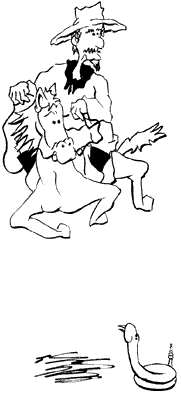
Tom found the regimen invigorating
Lillian Hammit Goes Crazy
It would be nice to say that Tom's travails were over. In reality they were just beginning. Tom continued teaching at some of the other schools and at the Art Students League and one of his students was a young woman named Lillian Hammitt. Tom was painting her portrait and she also corresponded with Tom off and on, asking Tom how to handle this or that personal matter. When Tom went off to North Dakota, Susan took it on herself to answer the letters and so everything seemed to be on the up and up.
So Tom was floored when he got a letter from Lillian talking about how they would handle his upcoming divorce with Susan and Tom and Lillian's subsequent marriage. Tom immediately (and quite properly) broke off any further contact with Lillian and stopped the portrait sittings (although by that time the picture was pretty much finished). He wrote back that he had no ideal what the heck Lillian was talking about and that he and Susan had every intention of staying married. He added that the only reason he could excuse such a letter was that he thought Lillian was nuts.
Although this was not a very understanding or tactful remark, it was medically quite accurate. Later Lillian showed up at Tom's home thinking she and Tom had been married, and she started calling herself Mrs. Eakins. Finally she was found wandering the streets of downtown Philly in her bathing suit. There wasn't much to be done but have her committed to a mental institution. No one knows what happened after that, but most likely she stayed there the rest of her life.
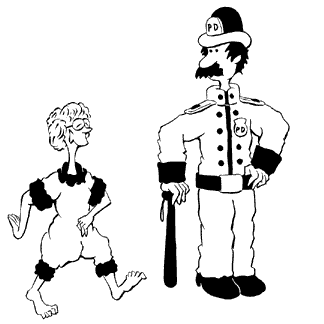
Lillian in Downtown Philly
The episode with Lillian, sad to say, was really a fairly minor blip. Far worse was to come. Once more this involved family, and this time it was with Fanny and Will, who had been two of his staunchest supporters during his troubles at the Academy.
Disaster - Will, Fanny, and Ella
William Crowell had graduated from Central High and had studied art there and in Paris along with Tom. As a young man he cut a quite dashing figure and had given up art to study law, and then he had given up law to buy the farm at Avondale. But not having enough money to make the purchase, he did what everyone else in the Eakins family did and borrowed the money from Tom and Fanny's dad (a debt, by the way, he never repaid despite some chiding from Benjamin). Once he was comfortably settled down on the farm, he (with Fanny's help) started churning out an almost continuous stream of little Crowells. Eventually there were ten kids, and they and Fanny were the ones who ran the farm. Will, quite literally, sat around on his rear end and read the newspapers.
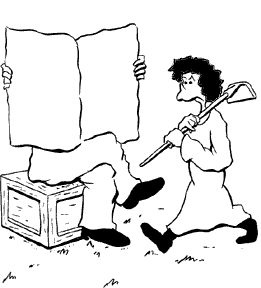
At Avondale, Pennsylvania
Much of what we know about the events with Fanny's family comes from a note that Susan wrote after the fact. The Avondale Eakins seem not to have been an entirely happy family with a dad who goofed off all day while the mom and kids slaved in the fields. So it would only have been natural for the kids to feel some resentment.
The oldest of the Crowell children was Ella. She seems to have been Tom's favorite (he gave her the rattlesnake rattle), and as a baby she was the subject of one of his nicer paintings. Next in line was Maggie, Ella's junior by two years, and by the time the girls were in their teens, they decided they had had enough of the good earth, at least at Avondale, Pennsylvania. Since their uncle was a famous artist, the best way to do get off the farm was to move to in with him and Susan and study art. And with this decision began some of the strangest correspondence to come out of the Eakins family - or any other family for that matter.
First Fanny wrote to Tom and Susan about "conditions" for Ella and Maggie. She knew of course about Tom's problems at the Academy and her main concern was that the girls would pose for each other in the nude. Worse, she was afraid that Tom or Susan would expect the girls to pose for them or (even still worse) that Tom or Susan would pose for the girls.
Fanny was very clear that she wanted none of this for her sweet innocent young things. Students posing, she reminded Tom, had caused him nothing but trouble and, besides it would be a most unhealthy experience for the young women. She ended the letter saying she felt that she was sending the girls to their doom.
Tom very forthrightly wrote back and said, well, if that's the way Fanny felt that way she shouldn't send the girls to Philadelphia at all. But if they were going to study art, figure drawing was necessary. Almost certainly they would pose for each other, and if the study of art required them to see each other, him, Susan, or anyone else in the buff then that's the way it had to be.
Fanny responded by pointing out that students posing had always required parental consent, which she was not giving. Again she begged Tom not to subject her girls to any nude studies unless it was with professional models in a classroom setting. This wasn't all that unreasonable, really, but still Tom, never one for compromise, would not agree to any conditions. Then Fanny, knowing full well how her brother felt, packed the girls off anyway and sent them to Philadelphia.
Fanny's actions may seem strange until you realize she was most likely trying to deal with two adolescent girls bent on getting away from home. They were probably raising hell, and if peace were ever to reign at Avondale, Ella and Maggie had to go to Philadelphia.
Despite Fanny's concern, things went well - at least for a while. The girls studied art and Ella agreed to help Susan with the housekeeping. Susan though was less comfortable with Ella's almost constant trashing of her parents. But as far as Ella and her uncle went, they got along quite well. Perhaps too well, and there are some aspects of their relationship that even now (or especially now) raises questions.
According to Susan, Ella was quite at ease, not to say familiar, with her uncle. Once she came home from a concert and said she didn't feel well. Tom (possibly at Ella's request) rubbed her back until she fell asleep. And there was also the time that Ella came into the parlor saying she had something in her eye and promptly plopped herself down on Tom's lap. Although this would have been no big deal if Ella had been a little girl of seven, it was not really the best way for a twenty year old woman to ask assistance from a fifty-year old uncle.
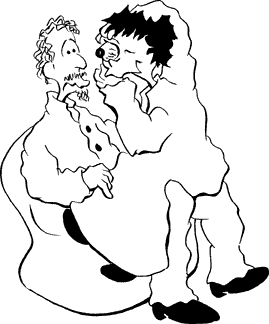
Ella had something in her eye.
Did anything go on between Tom and Ella? Who knows? But for some reason, within a year Ella had decided to give up art, although she and Maggie continued to live with Tom and Susan. She turned to nursing, but almost from the first, she ran into trouble. During the course of her duties she administered the wrong medicine to a patient. He came close to dying, and from that time on Ella's mental condition began to deteriorate.
Ella had always been high strung and subject to tantrums, but now she became so emotional that Susan wrote to Ella's parents that they should take her back home. Tom also wrote Will and Fanny that he would be doing extensive studies on the nude, and it wouldn't be appropriate for the girls to remain. This rings hollow, though, and it sounds more like Tom was inventing a scenario he thought would be sure to make Fanny take the girls back.
As far as Ella went, things got worse and they got worse fast. She tried to kill herself with the same medicine she had given the patient, and then she showed up with a loaded revolver at the home of Weda Cook, a young singer who had posed for one of Tom's most famous (and best) paintings. Ella held Weda at gunpoint for an hour and threatened to kill both her and Tom (who wasn't there). It was, Weda later said, the longest hour she ever experienced.
Finally Fanny and Will sent Ella to a mental hospital and then immediately flummoxed Susan by writing that this was all Tom's fault. Susan's memo is a bit garbled here but it appears that Ella spent as much of her time at home trashing her aunt and uncle as she spent in Tom's house trashing her parents. The net of it was that Will and Fanny said Tom "abused" Ella, but were characteristically vague on exactly what they meant.
It's pretty clear that Ella told her parents at the very least that Tom had taken some kind of "liberties" with her. But it's equally unclear if anything of the sort really happened. What is clear is Ella stayed in the hospital for several months and was then brought back home without any hint she was cured or even slightly improved. At this point Ella was more or less out of control, and her parents, still blaming Tom for it all, locked her up in her room. But after two months, Ella broke out, grabbed a shotgun, and killed herself.
For the rest of their lives, Will and Fanny blamed Tom for Ella's death. They never had anything more to do with him and wouldn't even let their other kids mention his name. For his part Tom never talked or wrote about Ella again.
Tom and Susan kept living at Mount Vernon Street. When Benjamin died at the end of 1899, he left the house to them and divvied up the rest of his estate equally between Tom and Fanny. He did, though, deduct the amount that Will owed him for the farm and presumably passed it along to Tom.
The New Millennium
Surprisingly after that last horrible decade of the nineteenth century, Tom's life was relatively smooth sailing. He started receiving some honors from various art organizations. For a man who once painted the President of the United States, it was certainly about time. He was also invited to serve as a judge for art exhibits, and finally he was elected to the National Academy of Design.
People even began to like his paintings. Walt Whitman said his portrait by Eakins, although not perfect, was the best anyone had ever done of him. Another picture, a full length portrait of Louis Kenton, Elizabeth MacDowell's (soon to be ex-) husband, was widely exhibited and praised. Eventually it ended up at the Metropolitan Museum of Art.
More importantly some of the people who had sided against him in the earlier controversies became his friends again. Elizabeth, for instance, took back all the bad things she had said about Tom making her pose naked and was a frequent and at times lengthy visitor with Tom and her sister. All in all this means that although there had been a lot of smoke and at least some smoldering in Tom's life, there was probably very little fire.
In 1912, Tom suffered a stroke and never painted after that. People who would come to visit would admire his paintings, and he sometimes gave them away. If pressed to accept payment, he'd take no more than $100.
Tom died in 1916, exactly one month shy of his seventy-second birthday. Within a year the curator at the Metropolitan staged an Eakins retrospective and in 1933, another and very long lived art curator, Lloyd Goodrich, published Tom's first biography. Drawn from interviews and correspondence from family, friends, and some enemies, Tom comes off as a paragon of virtue for truth, justice, and the American Realist way. Lloyd did leave out a lot of tidbits of the various scandals, probably because he didn't want to sully Tom's memory, but also because a lot of it was (and still is) hearsay and rumor. And besides, Susan, who lived until 1938, would have been ticked off.
A number of Tom's students went on to be successful, if not particularly famous, painters themselves. One of his favorite students, John Laurie Wallace, ended up in Omaha, Nebraska, of all places. It was he said, a bit conservative for him (John had been one of Tom's models who had posed nude out of doors). But nevertheless business in Omaha was lucrative enough for John to remain until he died in 1953. Henry Tanner, a young African American, studied art with Tom for two years and moved to Europe. His best paintings are, like "The Banjo Lesson", taken from everyday life of post-bellum African Americans, and Henry's true talent was often hidden by the way he focused on traditional religious themes in the style of the Renaissance masters. Henry, though, like all artists, had to a make a living. He remained in Paris until his death in 1937.
Thomas Anschutz, Eakins' student, assistant, and then opponent, continued to teach for a number of years at the Academy of Fine Arts and during his relatively short lifetime became one of it's most important teachers. His own students, Robert Henri and Everett Shinn, were among the pre-World War I "social realist" painters which were later dubbed the "Ashcan School". Anschutz himself died in 1912, four years before Eakins.
Tom Eakins, though, slipped out of the memory of the average American. His paintings, although not exactly cheap, never commanded the high prices of more popular artists like Picasso or Van Gogh. So maybe it really was Charles Schulz's cartoon that did the trick. Within a decade, Tom's paintings had begun to sell for prices commensurate with a nineteenth century master, and in 2003, one of Tom's paintings went for over five million.
Three years later, in 2006, Philadelphia's Thomas Jefferson Hosptial announced they were selling "The Gross Clinic", which it bought for $200, for 68 million dollars to one of the Wal Mart family. In other words, the painting that no one wanted was being sold by a health care facility for 34 million percent profit and for enough money that could be used to feed a third world family of six for over five thousand years. Tom had true artistic fame at last.
But probably Tom would have gained the recognition he deserved in any case. In the 1980's the aged wife of one of Tom's students, Charles Bregler, revealed that after Susan died Charles had squirreled away a huge cache of Eakins letters, drawings, and photographs. Thanks to this collection, Eakins scholarship got a major shot in the arm, and now everyone can go to the local bookstore or library and see pictures of Tom Eakins as naked as a jaybird. You can bet he would have loved it.
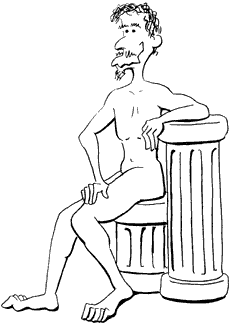
Tom Eakins: He would have loved it.
References and Commentary
"Writing about Eakins: The Manuscripts in the Charles Bregler Collection", Kathleen A. Foster, 1989, University of Pennsylvania Press. A summary and catalog of the Eakins memorabilia and letters that were kept by Eakins' remarkably long lived student Charles Bregler and then hoarded by his wife until the mid-1980's. Evidently when Susan died, Charles just went to the house and took away everything he could carry. In addition to a list of what's in the collection, the book reprints forty-two letters verbatim including the memorandum Susan wrote about her and Tom's relationship with Ella. Susan's memo is not exactly impartial and you wonder about its accuracy, but it is the most detailed account we have.
A very good book. Unfortunately, it has been a surprisingly hard to find volume. Either people hang onto their copies or the edition was pretty limited. For a while used copies went for $150 - $200 (as good a book as it is, that's too much) and this Merry History used a copy checked out from a library. A recent online book search, though, showed prices are dropping and you might find copies between $50 and $75.
"Thomas Eakins: His Life and Work", Lloyd Goodrich, Whitney Museum of American Art, 1933. The first major biography of Eakins. As is true in most first biographies, Tom is painted (no pun intended) as a near flawless monolithic figure although there are a few cracks in the stone. This is pretty easy to find and the cost of a fine copy can range from a few dollars to a couple of hundred. So shop around. A later revision came out in 1982 published by Harvard University Press, just before the Bregler Letters were discovered. It's thicker (two volumes) and more expensive.
The student of Eakins should still read these volumes despite the tendency to picture Tom a bit too idealistic and ignore the negative sides of his personality.
To his credit, Lloyd mentioned that some people found Tom's manner rather coarse. But when asked about that, Walt Whitman just shrugged his shoulders and said that people probably that about him too.
An online edition is at http://www.questia.com/PM.qst?a=o&d=72568470
"Thomas Eakins: His Life and Art", William Innes Homer, Abbeville Press, New York, 1992. A heavy (both literally and in content) biography of Tom. This was probably the first real biography to use the Bregler Letters. This has some nice reproductions of Tom's paintings but there's a bit too much trying to figure out what Tom was like and how he felt by how he painted. You can't do that.
"The Essential Thomas Eakins", Alice A. Carter, Abrams (New York), 2001. A nice introduction to Thomas Eakins. Physically it is a small book, perfect for carrying in your pocket. But the reproductions are good, again allowing for their much reduced size. More importantly, the author does not avoid mentioning Tom's quirks and negative side. If you want a quick reference for events in Tom's life, this is a good book.
"Thomas Eakins Rediscovered: Charles Bregler's Thomas Eakins Collection at the Pennsylvania Academy of the Fine Arts", Kathleen A. Foster, (principal author and editor), Yale University Press, 1998. Again a description of the Bregler letters and Eakins artifacts that were discovered in the mid-1980's. A large number of illustrations although many are quite small. A more accessible volume than the author's "Writing about Eakins" but it does not have the verbatim transcripts.
"Thomas Eakins: The Heroism of Modern Life", Elizabeth Johns, Princeton University Press, 1983. Before the Bregler letters were available to scholars, this was one of the definitive works. Typically for the times, Tom himself comes off a bit too noble, but you can still learn a lot. Tom's more famous paintings each have their own chapter and this is probably the best source for information of how Tom's times, environment, and society influenced what he painted. Today people may wonder why Tom made such a big deal about rowing, but you learn that in nineteenth century Philadelphia with no television, motion pictures or video games, about all you could do was go out on the river and row. From the number of boating clubs and how many people were members, it's surprising the Schuylkill could fit everyone in."
American Master Drawings and Watercolors: A History of Works on Paper from Colonial Times to the Present", Theodore Stebbins, Harper and Row, 1976. A nice book about drawing in America (the title explains its content). The chapter on the nineteenth century talks about Eakins and the author points out that some of Tom's so-called student drawings are really too good for a student. Mostly likely they were drawn when he was in his thirties. Tom, unlike the popular conception of an "inspired" artist, actually had to work hard to be as good as he was. Ten dollar softcovers are available but a good hardcover can cost between one and two hundred.
"American Realism", Edward Lucie-Smith, Thames and Hudson, 1994. Another nice book with a discussion on Eakins, what art influenced him, and who he influenced. Again very cheap paperback copies (under $10) are available but are moderately pricey for hardcover.
"The Art Schools of Philadelphia",William C. Brownell, Schribner's Monthly, Volume 20, Issue 1, September, 1879, pp. 737-751. The article where Tom was allowed to spout on his views. At the time the reporter visited PaFA, Professor Schuessele was in very poor health and obviously Tom did most of the talking. What's VERY insteresting is that the illustrations were from engravings of Tom's students who featured so prominently in his later troubles including Alice Barber, Charles Stephens, and Tom Anschutz. Other pictures were by Tom's future wife, Susan, and his friend Charles Fussell who as a young student painted Tom painting in the buff.
You don't need to waste time trying to find this in dusty library shelves. Cornell University and the University of Pennsylania have shown that not everyone is trying to milk every last dime out of all internet users and both have digitalized many historical archives. Just get on a browser and go to
http://cdl.library.cornell.edu/moa/moa_browse.html
Click on "Schribner's Monthly 1870-1881", enter "Eakins" into the search engine, and move down the window until you find "William C. Brownell The Art Schools of Philadelphia".
Or you can just enter (no spaces here)
http://dlxs2.library.cornell.edu/cgi/t/text/pageviewer-idx?c=scmo;cc=scmo;idno=scmo0018-5;node=scmo0018-5%3A11;frm=frameset;view=image;seq=755;page=root;size=s
as the URL and you'll hit page one of the article.
The next year (May, 1880) Schribner's published "The Younger Painters of America" by the same author about (what else?) the younger painters of America. It included some now greats like William Merrit Chase, John Singer Sargent, and of course, Tom. (who at thirty-six was young). The comments about how Tom's "power" almost makes up for his "lack of poetry" give you a good clue how Tom was regarded early on.
"Eakins Revealed: The Secret Life of an American Artist", Henry Adams, Oxford University Press, 2005. A long awaited volume suited to the "tell-all" culture of the late twentieth and early twenty-first century. There is a very nice chapter on the history of early Eakins scholarship, but as the title suggests this is mostly about the unpleasant parts of Tom's life. From that standpoint, the book can be useful for finding some details about the scandals that continuously plagued Tom. The work has an early discussion of Tom's home life and makes a good case that Mount Vernon Street was not the nineteenth century equivalent of the home of June and Ward Cleaver.
By looking over the notes of Tom's first biographer, Lloyd Goodrich, the author also shows that Lloyd learned a lot about Tom he didn't put in his books. But that might have been proper discretion since in interviews you can be peppered with hearsay, speculation, and innuendo (and Lloyd was). In works published while some of the individuals involved are still living, you have to be very careful about what you print. Dead people can be neither libeled nor sue for libel; living people can do both.
The scandals are conveniently divided into their own chapters and it would be wrong to say that this volume cannot be a useful reference. But overall this is a disappointing book. Much of the information is not really new since a major source (like all recent scholarly studies on Tom) is the Bregler collection which has been available to scholars for twenty years. And there is the strong tendency to predispose the reader against Eakins with irrelevancies. Before we're done with the first chapter we've learned that Tom's house smelled, it's walls hold deep dark secrets, his dad was a slumlord, and that Tom "murdered" (that's the word used) his sister's cat. If that's not enough we're told that in a class of art history at Case Western Reserve University some graduate students looked at a photo of Tom and said he looked either conniving or like a murderer. And we've still got over four hundred pages to go.
By far the worst parts of the book are the pages of dubious, not to say invalid, Freudian psychoanalyzing based on Tom's photographs and paintings. Determining a person's character or thoughts by the way he looks in a photograph has absolutely no scientific validity and neither can a persons' personality or mental state be accurately accessed from his artwork (using a mental patient's "art" as a tool for diagnosis is really after the fact rationalization and circular reasoning). Or if there are properly designed scientific studies that show you can do this, complete with proper controls, method validation, and published in reputable peer reviewed journals, please pass on the reference.
What's worse, if you dig for yourself, you can also find information that is just plain wrong. In the discussion of the episode of the mental breakdown of Tom's student, Lillian Hammitt (who ended up thinking she was Tom's wife), there is the suggestion that Tom's behavior - in general and possibly toward her - might have contributed to her mental breakdown. After all, we are told, she wrote lucid letters before she went crazy and she went crazy after she met Tom. The possibility she may have spontaneously developed a biochemically based mental illness like schizophrenia is dismissed. One of the reasons, we are told is that at 27, Lillian was too old for the onset of the disease.
But according medical texts, the disease most often develops in the early to mid-twenties for men and (pardon me for shouting) the LATE TWENTIES FOR WOMEN. More to the point, women have a wider range of onset - 26 to 45 - than men (18 to 25). So at 27, Lillian was right smack dab in the range for women.
We really do expect better from a major academic study published by Oxford University Press.
For a fuller Most Merry and Illustrated Review of this book, click here
"Thomas Eakins: Scenes from Modern Life", Public Broadcasting System. Tom's increasing fame has now given him the dubious honor of being featured on television. It's actually quite a nice film, but as expected in a one hour documentary, it covers the basics and not much more. However, the writers and producers amply illustrate Tom's thesis that showing naked people is really no big deal. They have photographs of Tom totally (and full frontally) nude, and you don't think anything of it. In what is perhaps the greatest tribute to Tom Eakins' philosophy, the show ends a beautifully filmed and editied shot of a modern PaFA art class in progress. The camera work and editing is so good that you hardly notice the model's (again full frontal) nudity although he's standing there as big as life. Once more, no pun is intended.
The informant about the art class on Parents' Day and the student who forgot to put on his pants prefer to remain anonymous.